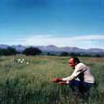



Dedicated to the development and extension of new technologies promoting sustainable
agriculture and ecological restoration
The
conservation
tillage
innovation
called
land
imprinting
was
invented
in
1976
and
then
patented
in
1980.
This
science-based
innovation
is
uniquely
capable
of
nearly
total
conservation
of
soil
and
water
resources
to
ensure
re-vegetation
even
in
arid
land
areas
such
as
the
Mojave
Desert
that
receives,
on
an average, 76 mm (3 inches) of rainfall, annually.
The
science
and
technology
of
sustainable
agriculture
and
ecological
restoration
are
merging
into
a
single
discipline
with
the
passage
of
time.
Agronomists
are
applying
some
ecology
and
ecologists
are
applying
agronomy
in
their
sustainable
agriculture
and
ecological
restoration
projects.
This
merger
of
the
two
disciplines
is
being
driven
by
a
common
concern
over
global
land
degradation
or
desertification
that threatens the welfare and even survival of all species, including our own.*
While
world
population
of
humans
is
growing
rapidly,
the
acreage
of
productive
land
is
shrinking
and
we
are
now
experiencing
shortages
of
food
and
medicine
worldwide.
Agricultural
lands
are
becoming
degraded
or
decertified
and
are
thus
less
able
to
provide
sustained
production
of
food,
feed,
and
fiber,
while
becoming
an
increasing
source
of
environmental
pollution.
Likewise
natural
lands
are
becoming
degraded
and
are
thus
less
able
to
provide
the
services
of
healthy
ecosystems
such
as
clean
soil,
water and air, pollination and abundant and diverse medicinal plants.**
Land
degradation
or
desertification
is
caused
by
such
human
activities
as
livestock
grazing,
forest
and
woodland
logging,
land
tillage,
outdoor
recreation,
urban
and
industrial
development,
and
military
activities.
The
foregoing
activities
cause
well
vegetated
land
to
become
denuded,
thereby
decreasing
rainwater
infiltration
and
increasing
water
runoff,
erosion,
sedimentation
and
flash
flooding.***
The
degraded
land
is
less
able
to
infiltrate
and
hold
soil
moisture;
consequently,
plants
experience
a
more
arid
environment,
especially
during
short
term
droughts.
A
vicious
cycle
of
land
aridification
and
denudation
forms
the
insidious
process
called
desertification,
wherein
the
land
dries
out
and
many
life
forms
die
or
flee.****
degraded
and
are
thus
less
able
to
provide
the
services
of
healthy
ecosystems
such
as
clean
soil,
water
and
air,
pollination
and
abundant
and
diverse
medicinal
plants.**
To
the
left is barren land prior to imprinting.
Land
degradation
or
desertification
is
caused
by
such
human
activities
as
livestock
grazing,
forest
and
woodland
logging,
land
tillage,
outdoor
recreation,
urban
and
industrial
development,
and
military
activities.
The
foregoing
activities
cause
well
vegetated
land
to
become
denuded,
thereby
decreasing
rainwater
infiltration
and
increasing
water
runoff,
erosion,
sedimentation
and
flash
flooding.***
The
degraded
land
is
less
able
to
infiltrate
and
hold
soil
moisture;
consequently,
plants
experience
a
more
arid
environment,
especially
during
short
term
droughts.
A
vicious
cycle
of
land
aridification
and
denudation
forms
the
insidious
process
called
desertification,
wherein
the
land
dries
out
and
many life forms die or flee.****
The
no-till
method
for
seeding,
called
land
imprinting,
has
been
under
development
in
Tucson,
Arizona
since
1976.
Ranchers
have
applied
imprinting
to
restore
perennial
grasses
on
their
degraded
range
land
for
erosion
control
and
forage
production.
The
degradation
has
been
due
to
a
variety
of
reasons:
overgrazing,
fires,
over
farming,
and
relatively
recently
discovered/publicized
global
warming
.
The
second
picture
shows
land
"imprinted"
in
order
to
collect
moisture
and
nutrients/resources
where
the
climate
produces
very
little
precipitation.
More
and
more
lands
are
facing
droughts
and
low
moisture
levels
due
to
global
warming.
Click
on
the
Barren
Land
picture
to
learn
more
about
this
very
serious
problem.
Click on the
Imprint
picture for one solution re:soil.
The
Dixon
Land
Imprinter
,
shown
above
right,
has
been
used
to
inter-seed
100,000
acres
with
grasses
in
southern
Arizona
since
1980.
Early
imprinters
were
massive
machines
with
large
diameter
rollers
that
were
designed
to
operate
on
rocky,
brushy
terrain
of
the
south-western
deserts.
The
Dixon
Land
Imprinter
is
a
very
simple
machine
consisting
of
only
two
moving
parts--the
imprinting
roller
and
the
seed-box
agitator.
Click
on
the
picture
for
specifications
.
This
machine
was
invented
by
Dr.
Robert
Dixon
,
internationally
known
soil
scientist,
leading
authority
on
sustainable
agriculture,
re-vegetation,
interseeding,
reclamation
seeding,
and
erosion
control
(to
list
just
a
few
of
the
topics
on
which
he
has
lectured/published
scientific
writings).
Click
on
the
menu
or
the
Results
picture
on
the
left
for
more
details
on
the
uses
of
this
agricultural
breakthrough
technology
and
how
imprinting
works.
Click
on
the
menu
at
left
or
the
Imprinter
picture
above
right
to
learn
about
the
machine
specifications.
Click
on
the
Scientific
Publications
to
learn
on
how
you
can
build your own hand-held imprinting machine according to the first two papers at the top.

Barren Land

After imprinting

Results
4 Months Later
Who can benefit from this site?

The Imprinting Machine
Developed by Dr. Dixon
THE IMPRINTING FOUNDATION:
New Hope for Damaged Lands
*(Lowdermilk, 1935; Dregne, 1978; Wolf, 1987) **(Buckman and Nabhan, 1996; Chevallier, 1996; Daily, 1997; Duke, 1998) ***(Dixon,
1995; Dixon and Carr, 1997) ****( Dregne , 1978)
Farmer,
scientist,
contractor,
large
agricultural
concerns,
government
agency,
anyone
open
to
learning
about
the
newest
technology
used
to
transform
barren
soil
into
fertile crop-producing land.
In
this
age
of
food
shortages
with
mass
starvation,
the
world
leaders
need
the
information
contained
in
this
site.
Through
networking,
we
can
get
the
information
out
that
there
is
a
machine
which
enables
the
earth
to
extract
moisture/resources
from
the
smallest
amount
of
precipitation.
Imprinting
machines
can
be
manufactured
large
enough
to
transform
thousands
of
acres
or
small
enough
to
work for the average farmer.
With
a
united
effort,
we
can
change
the
current
self
destructive
path
of
mankind
by
cooperating
with
nature
to
maximize
our
natural
resources.
This
is
an
exciting
time.
More
and
more
people
are
waking
up
to
the
food
crisis
we
are
currently
facing
and
are
stepping
up
to
the
plate
to
do
what
they
can
to
save
our planet -- save ourselves!
Come Join Us!!!
A Non-Profit Organization
The Imprinting Foundation
1616 E. Lind Road
Tucson, Arizona 85719


To email us, click on logo to left



Farmer,
scientist,
contractor,
large
agricultural
concerns,
government
agency,
anyone
open
to
learning
about
the
newest
technology
used
to
transform
barren
soil
into
fertile
crop-producing
land.
In
this
age
of
food
shortages
with
mass
starvation,
the
world
leaders
need
the
information
contained
in
this
site.
Through
networking,
we
can
get
the
information
out
that
there
is
a
machine
which
enables
the
earth
to
extract
moisture/resources from the smallest amount of precipitation.
Imprinting
machines
can
be
manufactured
large
enough
to
transform
thousands of acres or small enough to work for the average farmer.
With
a
united
effort,
we
can
change
the
current
self
destructive
path
of
mankind by cooperating with nature to maximize our natural resources.
This
is
an
exciting
time.
More
and
more
people
are
waking
up
to
the
food
crisis
we
are
currently
facing
and
are
stepping
up
to
the
plate
to
do
what
they can to save our planet -- save ourselves!

Dedicated to the development and extension of new technologies
promoting sustainable agriculture and ecological restoration
The
conservation
tillage
innovation
called
land
imprinting
was
invented
in
1976
and
then
patented
in
1980.
This
science-based
innovation
is
uniquely
capable
of
nearly
total
conservation
of
soil
and
water
resources
to
ensure
re-vegetation
even
in
arid
land
areas
such
as
the
Mojave
Desert
that
receives,
on
an
average,
76
mm
(3
inches) of rainfall, annually.
The
science
and
technology
of
sustainable
agriculture
and
ecological
restoration
are
merging
into
a
single
discipline
with
the
passage
of
time.
Agronomists
are
applying
some
ecology
and
ecologists
are
applying
agronomy
in
their
sustainable
agriculture
and
ecological
restoration
projects.
This
merger
of
the
two
disciplines
is
being
driven
by
a
common
concern
over
global
land
degradation
or
desertification
that threatens the welfare and even survival of all species, including our own.*
While
world
population
of
humans
is
growing
rapidly,
the
acreage
of
productive
land
is
shrinking
and
we
are
now
experiencing
shortages
of
food
and
medicine
worldwide.
Agricultural
lands
are
becoming
degraded
or
decertified
and
are
thus
less
able
to
provide
sustained
production
of
food,
feed,
and
fiber,
while
becoming
an
increasing
source
of
environmental
pollution.
Likewise
natural
lands
are
becoming
degraded
and
are
thus
less
able
to
provide
the
services
of
healthy
ecosystems
such
as
clean
soil,
water
and
air,
pollination
and
abundant
and
diverse
medicinal plants.**
Land
degradation
or
desertification
is
caused
by
such
human
activities
as
livestock
grazing,
forest
and
woodland
logging,
land
tillage,
outdoor
recreation,
urban
and
industrial
development,
and
military
activities.
The
foregoing
activities
cause
well
vegetated
land
to
become
denuded,
thereby
decreasing
rainwater
infiltration
and
increasing
water
runoff,
erosion,
sedimentation
and
flash
flooding.***
The
degraded
land
is
less
able
to
infiltrate
and
hold
soil
moisture;
consequently,
plants
experience
a
more
arid
environment,
especially
during
short
term
droughts.
A
vicious
cycle
of
land
aridification
and
denudation
forms
the
insidious
process
called
desertification,
wherein
the
land
dries
out
and
many
life
forms
die
or
flee.****
degraded
and
are
thus
less
able
to
provide
the
services
of
healthy
ecosystems
such
as
clean
soil,
water
and
air,
pollination
and
abundant
and
diverse
medicinal
plants.**
To
the
left
is
barren
land
prior
to
imprinting.
Land
degradation
or
desertification
is
caused
by
such
human
activities
as
livestock
grazing,
forest
and
woodland
logging,
land
tillage,
outdoor
recreation,
urban
and
industrial
development,
and
military
activities.
The
foregoing
activities
cause
well
vegetated
land
to
become
denuded,
thereby
decreasing
rainwater
infiltration
and
increasing
water
runoff,
erosion,
sedimentation
and
flash
flooding.***
The
degraded
land
is
less
able
to
infiltrate
and
hold
soil
moisture;
consequently,
plants
experience
a
more
arid
environment,
especially
during
short
term
droughts.
A
vicious
cycle
of
land
aridification
and
denudation
forms
the
insidious
process
called
desertification,
wherein
the
land
dries
out
and
many
life forms die or flee.****
The
no-till
method
for
seeding,
called
land
imprinting,
has
been
under
development
in
Tucson,
Arizona
since
1976.
Ranchers
have
applied
imprinting
to
restore
perennial
grasses
on
their
degraded
range
land
for
erosion
control
and
forage
production.
The
degradation
has
been
due
to
a
variety
of
reasons:
overgrazing,
fires,
over
farming,
and
relatively
recently
discovered/publicized
global
warming
.
The
second
picture
shows
land
"imprinted"
in
order
to
collect
moisture
and
nutrients/resources
where
the
climate
produces
very
little
precipitation.
More
and
more
lands
are
facing
droughts
and
low
moisture
levels
due
to
global
warming.
Click
on
the
Barren
Land
picture
to
learn
more
about
this
very
serious
problem.
Click on the
Imprint
picture for one solution re:soil.
The
Dixon
Land
Imprinter
,
shown
above
right,
has
been
used
to
inter-seed
100,000
acres
with
grasses
in
southern
Arizona
since
1980.
Early
imprinters
were
massive
machines
with
large
diameter
rollers
that
were
designed
to
operate
on
rocky,
brushy
terrain
of
the
south-western
deserts.
The
Dixon
Land
Imprinter
is
a
very
simple
machine
consisting
of
only
two
moving
parts--the
imprinting
roller
and
the
seed-box
agitator.
Click
on
the
picture
for
specifications
.
This
machine
was
invented
by
Dr.
Robert
Dixon
,
internationally
known
soil
scientist,
leading
authority
on
sustainable
agriculture,
re-vegetation,
interseeding,
reclamation
seeding,
and
erosion
control
(to
list
just
a
few
of
the
topics
on
which
he
has
lectured/published
scientific
writings).
Click
on
the
menu
or
the
Results
picture
on
the
left
for
more
details
on
the
uses
of
this
agricultural
breakthrough
technology
and
how
imprinting
works.
Click
on
the
menu
at
left
or
the
Imprinter
picture
above
right
to
learn
about
the
machine
specifications.
Click
on
the
Scientific
Publications
to
learn
on
how
you
can
build
your own hand-held imprinting machine according to the first two papers at the top.
Who can benefit from this site?
THE IMPRINTING FOUNDATION:
New Hope for Damaged Lands
*(Lowdermilk, 1935; Dregne, 1978; Wolf, 1987) **(Buckman and Nabhan, 1996;
Chevallier, 1996; Daily, 1997; Duke, 1998) ***(Dixon, 1995; Dixon and Carr, 1997)
****( Dregne , 1978)
Come Join Us!!!
A Non-Profit Organization
The Imprinting Foundation
1616 E. Lind Road
Tucson, Arizona 85719

Email Web Mistress
To email us, click on
logo to left



After imprinting
Barren Land
Results
4 Months Later
The Imprinting Machine
Developed by Dr. Dixon









































